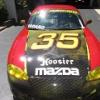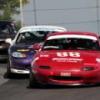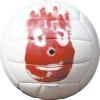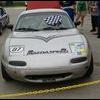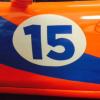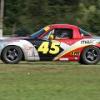
Rear wheel alignment - easier methods?
#1

 Posted 06-02-2011 11:44 AM
Posted 06-02-2011 11:44 AM

What I do now.
1. Bounce car on each side, roll backwards, then forwards.
2. Measure toe and camber settings.
3. Jack car and make camber adjustemnts.
4. Repeat until desired camber.
5. Adjust toe by trying to move both front and rear camber bolts at the same time, one clockwise and the other counter clockwise. Hoping to keep camber setting from changing much.
It just seems that I have to go back and forth between camber and toe, many, many times before I get it.
#2

 Posted 06-02-2011 12:23 PM
Posted 06-02-2011 12:23 PM

Frank
TnT Racing
SCCA Ohio Valley Region




#3

 Posted 06-02-2011 01:11 PM
Posted 06-02-2011 01:11 PM


#4

 Posted 06-02-2011 01:29 PM
Posted 06-02-2011 01:29 PM

I think you mean if you are off a tenth of a degree you may not go back and fix it. If you are off a degree you would definitely need to fix it.There is no real short cut to what you are doing. I have a lift so that cuts down on some of the time. As you do more of it you get used to what it takes and you can make few changes. I am a little more concerned about rear toe rather than camber I want the toe perfect but If I am a degree or two off on Camber i may not go back to fix it. It just depends on where I am at.


#5

 Posted 06-02-2011 01:34 PM
Posted 06-02-2011 01:34 PM



#6

 Posted 06-02-2011 06:35 PM
Posted 06-02-2011 06:35 PM

As you do more of it you get used to what it takes and you can make few changes.
+1 I don't have a lift and the first time I did my alignment, the first corner was a bloody PITA. Crawling under the strings each time got old very quickly. It seemed like some sort of ill concieved excercise program. After mucking about for a while I started to figure out how to adjust both the camber and toe at the same time. Things went much quicker from there.
A proper caster camber gauge helps. Using my Sears digital laser level but holding the level on the toe stick while trying to position the stick on the rim and getting it vertical drove me crazy. I also quickly learned why some people keep a set of daisy wheels on hand for doing their setup.



#7

 Posted 06-02-2011 08:06 PM
Posted 06-02-2011 08:06 PM

I think you mean if you are off a tenth of a degree you may not go back and fix it. If you are off a degree you would definitely need to fix it.
Yes you are right. down to a tenth of a degree.
Frank
TnT Racing
SCCA Ohio Valley Region




#8

 Posted 06-02-2011 08:52 PM
Posted 06-02-2011 08:52 PM

We use known straight stock alloy wheels because the lip on the rims hold the smart camber gauage w/ hands free perfectly. No, different width and diameter doesn't matter, and even if you don't agree, just remember repeatability is what matters most.
-bw
I have an opinion so I must be right




#9

 Posted 06-03-2011 01:47 PM
Posted 06-03-2011 01:47 PM

Try sitting the car up on a few 2x12's cut to about two feet in length and screwed together. Shim them as level as you can and place a couple plastic trash bags between the tires and the 2x's. That will give you plenty of room to get under the car to adjust the cam bolts w/o interfering with the strings and let the tires move w/o having to roll or bounce the car. I find that jacking the car moves the string frames enough to change the measurments. If you feel you must roll the car the blocks are long enough to handle it. I put little "cleats" on the blocks so the car can't roll or slip off.
When adjusting the rear's, I roll the cam bolts IN to give the wheel much LESS camber than I want. Then I roll them out just enough to get the toe pretty close to what I want. Then with a wrench on each cam bolt I roll them out together until I'm about a half a degree shy of my goal camber. The last half degree of camber is gained tweaking the toe (by rolling the bolts OUT) until it is perfect.
Works for me. YMMV.
Good luck.


#10

 Posted 06-03-2011 05:27 PM
Posted 06-03-2011 05:27 PM

CheckerLap.com -- Your race results!




#11

 Posted 06-03-2011 06:42 PM
Posted 06-03-2011 06:42 PM

Some tips on the rear toe -
- Use slip plates. A lot of time is wasted rolling the car back and forth.
- If you've got scales and scale pads use them. The extra height is a real help. .
- There is not too much bump steer back there (if any?). Measure the toe with the car on the ground and determine how much needs to be done. Then get the car up in the air. Still using the strings as a reference, Move the adjustment the amount needed to make things right with the car on the ground. This will get you 90-95% of the way there. Good for 'roughing' things in.
- Turn the cam bolts around so that all the bolt heads are facing to the rear. Break loose the cam adjusters and leave them a little snug to just hold things in place. Put the car back down on the slip plates. Now you can get to the adjusters with a couple of long 1/2" extensions and a wobbly You can make your toe and camber adjustments w/o going up and down a zillion times.
Mark
Mark
markn@ironcanyonmotorsports.com
Iron Canyon Motorsports


#12

 Posted 06-03-2011 08:08 PM
Posted 06-03-2011 08:08 PM

I also use a 2 post lift. I use scales on the floor and 2x 12 to match scale height so I can roll car. I use the Canyon string for alignments then use lift for adjustments.
Are the race ramp stands 14 inch high?
What are you using for slip plates?
What are using to prevent rolling off stands?
Thanks for your post
John



#13

 Posted 06-03-2011 08:16 PM
Posted 06-03-2011 08:16 PM

Frank
TnT Racing
SCCA Ohio Valley Region




#14

 Posted 06-03-2011 08:40 PM
Posted 06-03-2011 08:40 PM

For low buck slip plates I like something like 1/16" thick 12" square metal plate sandwiched with a bit of oil or grease between the plates. If desperate I'll use industrial acrylic floor tiles from Home Depot and do the same. These don't hold up too well though as they are brittle when cold and soft and flexible when hot but at $1 ea who cares? I have not had good success with plastic bags as slip plates though others swear by them. When the car is on the stands and scales I have the car in gear and hovering just off the lift arms to catch it should anything move along with a couple of pieces of angle stock to act as a wheel chocks. Race Ramp wheel stands are 14", add another 2.5" for the scales. Very nice for working under the car. Pretty tough to get a car up that high without a lift. I used to use 10" high stands but with a lift height is no longer an issue and the Race Ramp stands are nice as they weigh almost nothing so it is really easy to move them around.as needed.
Mark
markn@ironcanyonmotorsports.com
Mark
markn@ironcanyonmotorsports.com
Iron Canyon Motorsports


#15

 Posted 06-04-2011 05:40 PM
Posted 06-04-2011 05:40 PM

didnt realize you came out with Iron canyon string alignment,talk to you before I purchase your string system,you were very helpful,like your product,it is like seat time ,the more you spend the better you get,I enjoy learning the setup almost as much as driving.I have the tiles your referring to,I use them as spacers to level out my scales. I try the stands,thanks again for your help.



#16

 Posted 06-04-2011 06:53 PM
Posted 06-04-2011 06:53 PM

#17

 Posted 06-04-2011 08:30 PM
Posted 06-04-2011 08:30 PM

If you want proper grammer,check out spec grammer.com



#18

 Posted 06-06-2011 08:29 AM
Posted 06-06-2011 08:29 AM

#19

 Posted 06-06-2011 07:27 PM
Posted 06-06-2011 07:27 PM

I do like the suggestion about getting the camber close first, then be super precise with toe and if the camber falls back 0.1, then call it good enough. I have been trying to manage to within 0.1 for my desired camber and within 1MM for my toe settings. Maybe I can relax a little on being so precise on the camber.
Dave, if you're around in about two week's, I may ask you to come over for a visit while I'm doing the setups. We may learn from each other. I think I have a good method, but it just takes time, especially doing it all by myself. I am shooting to be on track for the Waterford Hills July 2nd open track day. Are you or your kid planning to be there?
#20

 Posted 06-06-2011 08:58 PM
Posted 06-06-2011 08:58 PM

-bw
I have an opinion so I must be right




1 user(s) are reading this topic
0 members, 1 guests, 0 anonymous users




 Sign In
Sign In Create Account
Create Account



 Back to top
Back to top Report
Report
